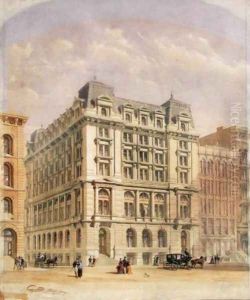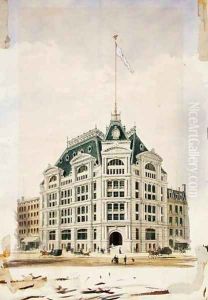George Browne Post Paintings
George Browne Post was an influential American architect who played a significant role in the development of skyscraper design in the late 19th and early 20th centuries. Born on December 15, 1837, in Manhattan, New York, Post was educated as an engineer, graduating from the New York University in 1858 with a degree in civil engineering. His interest in architecture was sparked during his education, leading him to pursue a career that would eventually make him one of the most notable architects of his time.
After completing his studies, Post worked for a brief period as a civil engineer before turning to architecture. He established his own architectural firm in New York City, where he began to make his mark with a series of designs that ranged from commercial buildings to residential projects and public institutions. Post's architectural style was characterized by a blend of classical and Renaissance influences, which he skillfully adapted to meet the needs of modern construction and the tastes of his clients.
One of Post's most famous works is the New York Stock Exchange building, completed in 1903. This iconic structure exemplifies his ability to combine classical architecture with the requirements of modern finance and technology, creating a space that was both functional and aesthetically pleasing. Another significant project was the Wisconsin State Capitol, which showcased his talent in designing public buildings that were majestic yet accessible to the citizens they served.
Throughout his career, Post was also a pioneer in the use of steel-frame construction, which allowed buildings to reach unprecedented heights. His work on the Manufactures and Liberal Arts Building for the World's Columbian Exposition in Chicago in 1893 was a testament to his innovative approach to architecture. The building was one of the largest of its time and demonstrated the potential of steel as a structural material, paving the way for the skyscrapers that would come to define American cities.
George B. Post's contribution to architecture extended beyond his buildings. He was a founding member of the American Institute of Architects and served as its president from 1896 to 1899, advocating for the professionalization of architecture and the importance of architects in shaping the built environment. Post's legacy is seen not only in the buildings he designed but also in the standards he set for the profession and the advancements he made in architectural technology.
George Browne Post passed away on November 28, 1913, leaving behind a body of work that continues to be celebrated for its innovation, beauty, and impact on American architecture. His designs remain a testament to the transition from traditional to modern architecture, reflecting the changing landscape of America during his lifetime.

